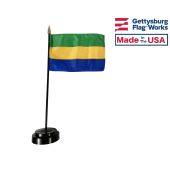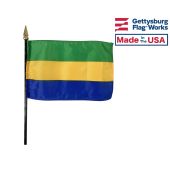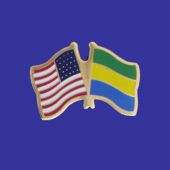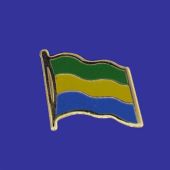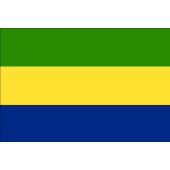Flag of Gabon
Flag of Gabon
The history of Gabon's flag resembles that of other French colonies in Africa. The first Gabon flags can be traced back to the period immediately prior to the nation's independence, when France began to allow its colonies to represent themselves with unique flags.
The flag of Gabon is a horizontal tricolor flag. The top stripe is green, representing the forests; the center, gold, representing the equator; and the bottom, blue, representing the sea. The flag of Gabon is strikingly similar to the flag of Bandung, Indonesia.
- Capital of Gabon: Libreville
- Area of Gabon: 257,667 sq. km
- Languages used in Gabon: French (official), Fang, Myene, Nzebi, Bapounou/Eschira, Bandjabi
- Currency used in Gabon: Christian, animist, Muslim
Colors and Symbolism of Gabon Flags
Modern Gabon flags are horizontal tricolors of green, yellow, and blue that do not display any emblems. The green stripe represents the nation's forests, which account for a significant part of the Gabonese economy. The blue band represents the sea and Gabon's large coastline. The yellow band that divides the other two is a reference to the Equator that runs through the country as well as the sunlight that blankets it. The flag's proportions are particularly noteworthy, since it shares the 3:4 proportion with only two other national flags in the entire world. The flag also stands out from those of most of the nations that border Gabon because it does not resemble the Pan-African flag.
History of Gabon Flags
Gabon did not have a flag of its own prior to its time as a French colony, nor did it have a flag until the very end of the colonial period. Gabon first became a French colony in 1839, at which point it was represented by the national flag of France. The French government specifically forbade Gabon and its other colonies from adopting flags of their own in order to make sure that nationalist sentiments did not develop in the colonies and lead to independence movements.
That policy changed when the decolonization movement began to gain power in Africa after the end of the second world war. France began to allow its colonies to exercise greater autonomy within their own territory, including the right to adopt their own flag. Gabon was one of the first colonies to complete its own design. The design was similar to the modern flag, but the yellow band was much thinner and the flag of France was displayed in the canton. It came into use in 1959.
The design was changed in 1960. The Gabonese government removed the French tricolor from the canton and adjusted the size of the three bands to be equal. The new design came into use in 1960, just one week before Gabon gained complete independence from France. The design has been used ever since, which makes Gabon one of the few nations to only use one flag in its time as an independent state.
